Les articles de Paul Marillier
DAGUERRE, CLAUDET, LEREBOURS:
their early use of "instantaneous" daguerreotypes
Portraits by DAGUERRE
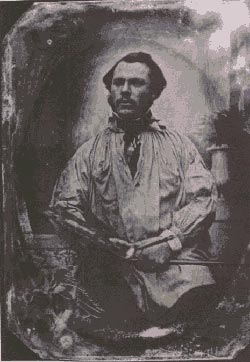 | François Jules COLLIGNON, painter and engraver. He was the husband of Marie Félicité, called Felicity, daughter of Charles ARROWSMITH, brother of Madame DAGUERRE. COLLIGNON died on 15 November 1846 at Bry-sur-Marne at DAGUERRE's house Daguerreotype, 1/2 plate
Signed by DAGUERRE, at bottom left corner Date probably: 1843 Provenance: the mysterious collection of Gabriel CROMER (daguerreotype preserved at Georges Eastman House) (Reproduction from the archives of the historian P. G. HARMANT) * see also for COLLIGNON: the portrait of DAGUERRE, as the frontispiece of the second edition of DAGUERRE's Manual. |
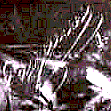
The signature on the daguerreotype above, (image manipulated to improve visibility in this reproduction) | 
Death Certificate of François COLLIGNON: Transcript of Death Certification |
(the list is not exhaustive...):
- Louise Georgina, DAGUERRE's wife, born ARROWSMITH, god-daughter of Princess de Lamballe ... Madame DAGUERRE was Protestant and her godmother Catholic. A tolerance due to the rank of the latter? But it explains the relationship between DAGUERRE and the King.
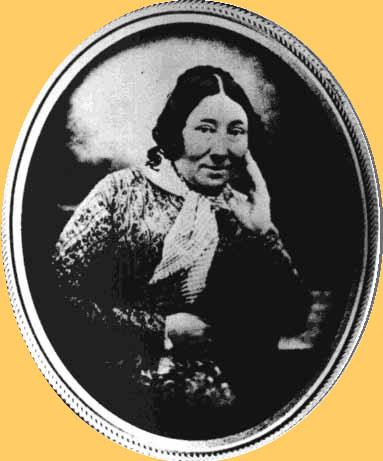
- Georgina, daughter of John Arrowsmith (brother of Madame DAGUERRE), at age 19.

- COLLIGNON, painter and engraver
- GOSSE, [his assistant] painter and decorator; on the back one can read: "To my friend, GOSSE, DAGUERRE, made in six seconds, in misty weather in 1843" (collection of M. Aimé Girard, of the SFP).
- Portrait of an young man (identity unknown), (collection Nadar, later collection BNF).
- MORSE *, the inventor, 1843; attributed to DAGUERRE.
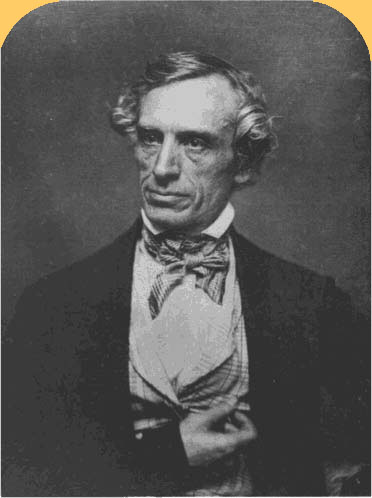
- DAGUERRE's cook, at Bry. (Given by DAGUERRE to Arago)

- Portrait of an unknown man. (Given by DAGUERRE to Arago) (Collection of Lo Duca, who entitled it "The Miser")
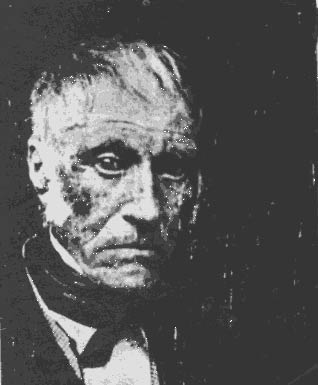
By 1843, DAGUERRE realised the advantage of the smaller format, half- and quarter- plates, and the preparation of those plates with accelerators that enabled "instantaneous" portraits. He daguerreotypied his family, his friends, everything - and I almost forgot, the small dog Médor (collection Braive), quoted in a letter to Isidore Niépce (9 july, 1837): "Je vous remercie, mon cher Isidore, de l'envoie de pain d'épices, que vous nous faites pour notre petit Médor, je suis persuadé qu'il sera bien sensible à cet aimable souvenir de votre part et qu'à la prochaine occasion il vous dévorera de caresses."

DAGUERRE's signatures
Daguerreotypes taken by DAGUERRE himself were usually signed, at the bottom-left corner, with an etching needle. Sometimes, DAGUERRE, identified daguerreotypes by putting on the plate a date not connected with the taking of the portrait. This information appears in a dossier compiled by PGH on the subject. From that dossier, here are some examples of DAGUERRE's [autograph] signatures:
 |  |
| "on daguerreotype after 1839" | "on 1829 contract in Châlon" |
  |  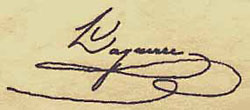 |
| "on contract from June 22, 1839, with Giroux" | "letter from July 1st, 1839" |
| DAGUERRE's signatures, by PGH | |
Relics of DAGUERRE
At a public auction (apparently in 1853), his possessions were dispersed, including those described as "from the Laboratory of DAGUERRE ". Several of the purchasers became known later:
- M. BENOIST, optician in Paris, for a drawing box known as a " Vitre italienne ".
- M. BAPTEROSSES, industrialist at Briard,
- and his friend, Dr LOREAU *, of the Salpêtrière,
who aquired two camera obscuras, bottles of mercury, of iodine, pastel, in all more than 20 pieces.
- ... TOURNACHON-NADAR, established as a photographer in 1853, who brought "the last cameras of DAGUERRE".
A portrait that is not by DAGUERRE

King Louis-Philippe. Date probably: June/July 1842.
The portraits of King Louis-Philippe and Queen Amélie are preserved at the Archives Nationales de Paris - The following appeared in the "Bulletin de la Société Française de Photographie" (February 1975):
"EN CE TEMPS-LA, ... LA PHOTOGRAPHIE...
"En ce temps-là, la photographie s'appelait DAGUERREOTYPE et le photographe, humble servant de cette démocratique invention, ne signait pas ses travaux... Aussi ne connaitrons-nous jamais les noms des auteurs des daguerréotypes de Louis-Philippe et de la reine Amélie, son épouse, que viennent de trouver les Archives Nationales en explorant le fonds documentaire dont Mgr le Comte de Paris a fait don.
"L'exploitation de ces archives, jusqu'à maintenant privées donne lieu à une exposition à l'Hôtel de Rohan, sur le thème : Louis-Philippe, l'Homme et le Roi (1773-1850)"
Abstract: the article says daguerreotypist didn't sign their works, that Louis-Philippe and Queen Amélie's portraitists will never be known, than the daguerreotypes were found in Archives Nationales among documents given by His Lordship the Count of Paris and that are exhibited in Hôtel de Rohan.
... But one can read in a note of N.P. LEREBOURS (published at the time of the portrait):
"Un exemple pris au château des Tuileries peut donner une idée de la différence de temps pour un portrait pris à l'intérieur et à l'extérieur. Lorsque nous fûmes admis, M. Claudet et moi, à faire le portrait du roi et d'une partie de la famille royale, le temps était voilé par des nuages blancs extrêmement lumineux. A deux mètres de distance des fenêtres immenses qui donnent sur le jardin (c'est-à-dire au couchant), il nous fallait avec les appareils 1/4 à double objectif, 85 secondes. Toutes les circonstances restant les mêmes, mais en plein air, sur la terrasse de Philibert de Lorme, 15 secondes nous suffisaient. Aussi produisîmes-nous, à cette exposition, plusieurs bons portraits en moins d'un quart d'heure."
Abstract: When Lerebours and Claudet took photographs of the king and royal family, in Tuileries castle, the sky was veiled with very bright white clouds; they were working 2 meters [6.5 ft] from huge windows facing West. With 1/4 plate double lenses cameras, shooting took 85 seconds. With the same weather, in the open, 15 seconds were enough. During this session they made several good portraits in less than a quarter of an hour.
Who were these two photographers, "admitted to make the portrait of the king"?:
- Antoine, François, Jean CLAUDET, born in France (Lyon), on Jul. 16, 1797, died in London Dec. 27, 1867.
He made many improvements in optics, stereoscopy, and devices for checking exposure and lenses, etc.
In May 1841 he brought in an improvement by preparing daguerreotype plates with an accelerator of iodine chloride (exposures from 10 to 20 seconds).
His friend N. P. LEREBOURS manufactured his objectives, his cameras, etc.
His work, his skill made him worthy to be named photographer to the Court of England.
- Noël, Paymal LEREBOURS
Declares the birth of a male child born on February 16, 1807, of unknown father, by the name of Noël PAYMAL [not Napoléon, as it is often read!].
The child is adopted by decision of the Tribunal on June 11, 1836 by Noël, Jean LEREBOURS, optician, 13 place du Pont-Neuf, born in Mortain (Manche) on Dec. 25, 1761.
Five years after the death of his father (February 13, 1840), N. P. LEREBOURS joined, on 15 February 1845, with Marc Louis François SECRETAN (born in Lausanne in 1804). These two partners extended their manufacture to the large equipment of astronomical observatories, lenses and telescopes of several tons.
He's the one who successfully begged for his friend CLAUDET to be allowed to photograph the King.
 |
 |
| Reproduction extracted from: "Le Musée Rétrospectif de la Photographie à l'exposition universelle de 1900", by A. Davanne, Maurice Bucquet, and Leon Vidal. Published by Gauthier-Villars, Paris 1903. |
| Captioned: "Engraving from Daguerreotype (1844). (Lerebours, optician; Martens, inventor of the first panoramic apparatus applied to the daguerreotype; Antoine Gaudin.)" |
| The text itself indicates: "another plate also exposed represented a group, less successful, but interesting, in which one finds Lerebours, associated with Secrétan, celebrated opticians of that period; Martens, the inventor of the panoramic apparatus mentioned above; Marc-Antoine Gaudin, Calculator at the Bureau des Longitudes, and Adolphe Martin, Professor of Physics whose scientific research contributed to progress of optics and photographic chemistry; this Proof belongs to Madame Darlot." |
| That text contains an obvious error: Adolphe Martin (1824-1896) was at the age of twenty years, and was not yet a professor! He invented the ferrotype in 1852.
Madame Darlot, who presented this daguerreotype in 1900, was the widow of the optician Alphonse Darlot (Seignelay, Yonne, Sep. 3, 1828 - Oct. 5, 1895). Darlot served his apprenticeship, became "journeyman" and obtained his Mastership at the age of twenty-one, at the optician's shop of Noël Marie Paymal LEREBOURS. He established himself at the outset as optician at 2/4 Place Dauphine in Paris. The two unidentified persons wear the blouses of workmen, and are undoubtedly Supervisors or workshop Foremen. |
| For all information relating to Gaudin brothers, you can consult with profit "Gaudin Frères, Pionniers de la Photographie - 1839-1872", by Denis Pellerin, published by Société des Amis du Musée Nicéphore Niépce, à Châlon-sur-Saône, 1997. |
One of the earliest "instantaneous" daguerreotypes, by N. P. LEREBOURS
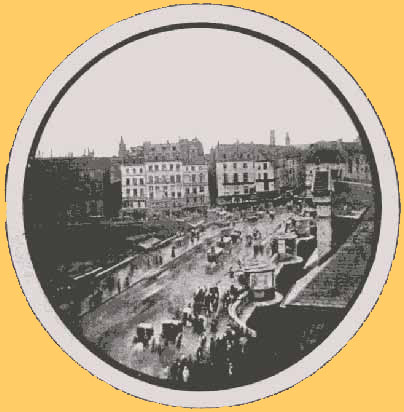
Le Pont-Neuf
LEREBOURS, in a notice of 1842, indicates that in the second half of 1841 "I made 1500 portraits!" (with hypersensitization using the accelerators of CLAUDET or of FIZEAU, work published at the beginning of 1841)
Particulars of some of the displayed documents
- Portrait of MORSE: collection BAPTEROSSES and later- in 1900 - the collection LOREAU.
- "Pont Neuf", daguerreotype by N.P. LEREBOURS (date probably 1841): this daguerreotype was unknown until revealed in 1900 by the then owner, Michel BERTHAUD, who produced a phototypie [of the image].
© 1999, Paul & Claude Marillier